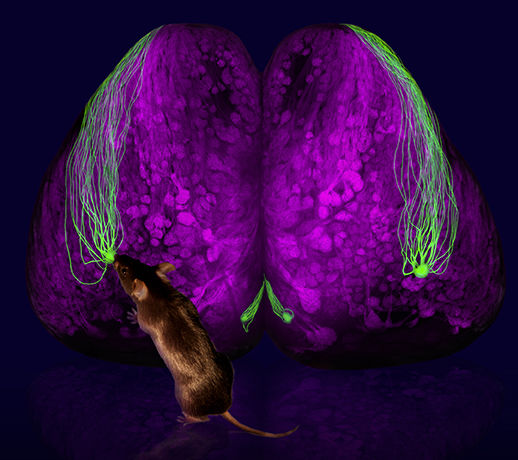
Basics
Olfaction
Mammalian olfaction has unique structural and functional characteristics as a system for studying sensory processing. Each channel of sensory information has a specific genetic tag. Compared to the visual or auditory systems, the neuronal organization of the olfactory system is relatively simple: receptors are only "two synapses away" from the cortex, and the flow of information to the cortex bypasses the thalamus. Direct corticobulbar projections, which are analogous to corticothalamic projections in other sensory systems, are presumed to be responsible for feedback control of the olfactory processing. Overall, the availability of modern genetic tools, the relative simplicity of the neuronal circuitry, and the extremely high relevance of smells to animal behavior makes olfaction a great model system for studying the principles of sensory information processing.
Dancing-Lemon studio Copyright
This animation shows how information about smells is processed by the nervous system. Molecules travel through nose and activate olfactory receptor neurons (ORNs) on the surface of the epithelium. ORNs express one and only one olfactory receptor gene from the large family of genes (human: ~350, mouse: ~1200). The axons of ORNs, which express the same receptor gene, converge into one or few small areas in the olfactory bulb, called glomeruli. Olfactory bulb is the first processing center in the brain of the information about odorants. The principle olfactory bulb neurons, mitral/tufted cells, receive their inputs from the glomeruli and send their outputs to the olfactory cortices. Their activity is modulated by a vast network of inhibitory interneurons.
Neural coding
To understand the sensory processing, we need to understand how information is represented by neuronal activity at different levels (1,2), and which features of neuronal activity is read by the brain and leads to behavior (3). In addition, the feedforward flow of information from sensory system to motor output is modulated by feedbacks at multiple levels (4,5..), including direct effects of behavior on extracting of sensory information (6).
Research in the lab is directed towards understanding different arrows at this diagram: what computations are responsible for processing sensory information, and how these computations are implemented in neural networks.
